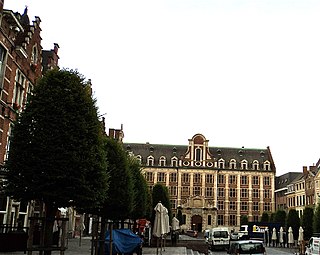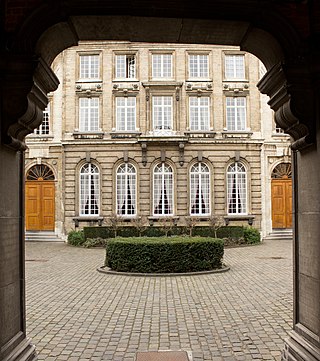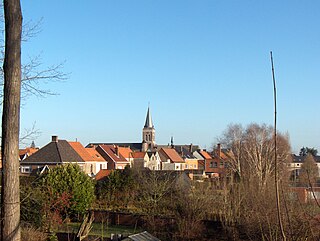
Koksijde is a town and a municipality in Belgium. It is located on the North Sea coast in the southwest of the Flemish province of West Flanders.

Melsele is a town in the Belgian province of East Flanders, between the city of Beveren and the nearby town of Zwijndrecht. Tram route 3 which starts just outside the town connects it to Zwijndrecht and Antwerp. The town's road links include the E17 and the E34.

Michelbeke is a village in the municipality of Brakel, Belgium. It is located in the Denderstreek and in the Flemish Ardennes, the hilly southern part of the province of East Flanders, Belgium. It was itself a municipality until the fusion of the municipalities on 1 January 1971.

Erwetegem is a village and deelgemeente (sub-municipality) belonging to the municipality of Zottegem. It is located in the Denderstreek and in the Flemish Ardennes, the hilly southern part of the province of East Flanders, Belgium. Erwetegem used to be an independent municipality until 1970.

Zevergem is a village and deelgemeente (sub-municipality) of De Pinte in East Flanders, Belgium. It is located on the Scheldt about 8 kilometres (5.0 mi) south of Ghent.

Kieldrecht is a village and deelgemeente (sub-municipality) of Beveren in East Flanders, Belgium. Kieldrecht was an independent municipality until 1977, when it merged with Beveren as part of the fusion of municipalities in Belgium. The village is located on the border with the Netherlands, and forms a single urban area with the Dutch village of Nieuw-Namen.

Kruikenburg Castle is a listed building in the village of Ternat, Belgium. It was the seat of the lordship of Kruikenburg, which included the villages of Ternat, Sint-Katarina-Lombeek and Wambeek. A medieval foundation, the castle was extensively remodelled in the 16th and 18th centuries, giving it its current appearance. In 1662 the lord of Kruikenburg was elevated to the title of count. In the 20th century the castle became a house of the Lassalian Brothers.

St Anne's College was one of the colleges of Leuven University, now listed as built heritage of Flanders, Belgium.

The Irish College of St Anthony, in Leuven, Belgium, known in Irish: Coláiste na nGael i Lobháin, Latin: Hibernorum Collegii S. Antonii de Padua Lovanii, French: Collège des Irlandais à Louvain and Dutch: Iers College Leuven, has been a centre of Irish learning on the European Continent since the early 17th century. The college was dedicated to St. Anthony of Padua.

Trinity College was one of the colleges of Leuven University, dedicated to preliminary studies in the liberal arts. The college was established by the university authorities in 1657 to replace the "Collège de Gand" founded by Frans van de Nieulande in 1559, which had closed in 1655 for lack of funds. Building began in 1658, under the supervision of Jan du Can and Adriaan van Mechelen, and from 1659 the college was housed on the Old Market. It was sometimes known as "Collegium Novum". The college was sequestered when the university was closed down in 1797 during the French occupation. The buildings were sold at public auction in 1802. The southern wing, added in 1684, was demolished in 1813. The final remnants of the 17th-century buildings were destroyed by aerial bombardment in May 1944. Since 1843 a Josephite secondary-school, Heilige Drievuldigheidscollege, has stood on the location.

Ten Duinen Abbey or the Abbey of the Dunes was a Cistercian monastery at Koksijde in what is now Belgium. It was one of the richest and most influential religious institutions in the medieval County of Flanders. It later relocated from Koksijde to the city of Bruges.

Holy Ghost College was one of the colleges of Leuven University, now listed as built heritage of Flanders, Belgium.
The Major Seminary in Ghent was an institution for the training of Catholic clergy for the diocese of Ghent, first founded in 1569. It has been established at three different locations in the city. Since 2006 diocesan clergy from Ghent have been trained in Leuven.

The Colonial University of Belgium was an institute of higher education located in Antwerp. Founded in 1920, the institute was established to prepare students for a careers as colonial functionaries in the Belgian Congo and Ruanda-Urundi. It was renamed the University Institute of Overseas Territories in 1949. It was dissolved in 1962.

The King Albert I Memorial, also named the King Albert I Monument is a memorial at the Belgian coastal city of Nieuwpoort. It is located right outside the old town, on the right bank of the Yser river at the lock complex Ganzepoot. The monument was erected in 1938 after a design of Julien de Ridder and honours both King Albert I of Belgium and the Belgian troops at the time of the First World War.

Prinsenkasteel was a castle located in Grimbergen, Belgium. It was the residence of the lords of Grimbergen from the 14th Century onwards. The castle ruins are located in Prinsenbos Park.

Bevere is a village in the municipality of Oudenaarde. It is located in the Flemish Ardennes, the hilly southern part of the province of East Flanders, Belgium. In the mid-19th century, it started to form a single urban area with Oudenaarde, but retained some rural parts.

The Diocesan Pastoral Centre Mechelen is a centre for pastoral activities and ecclestical administration, which also houses the diocesan archive of the Archdiocese of Mechelen-Brussels. It is located on the two-acre site of what was formerly the Major Seminary in Mechelen, an institution for the training of Catholic clergy in the archdiocese from 1595 to 1970. Since 1936, increasingly extensive parts of the site have been listed with the status of a protected monument.

Arras College was a college at the Old University of Leuven that provided accommodation for poor students in the Liberal Arts who intended to train for the priesthood. The founder was Nicolaus Ruterius, Bishop of Arras, a native of the Duchy of Luxembourg who had been chancellor of the university and provost of St. Peter's Church, Leuven.


















